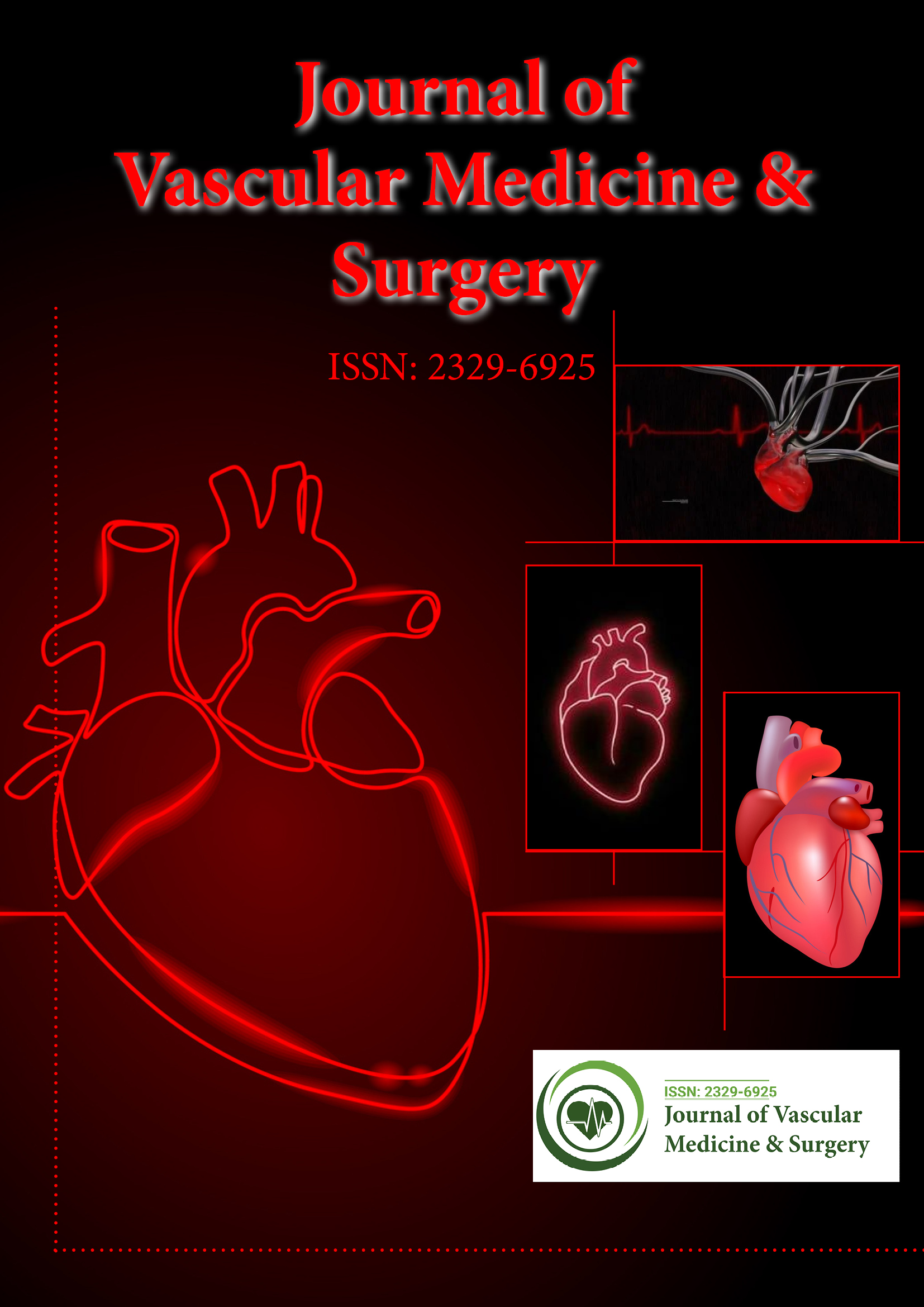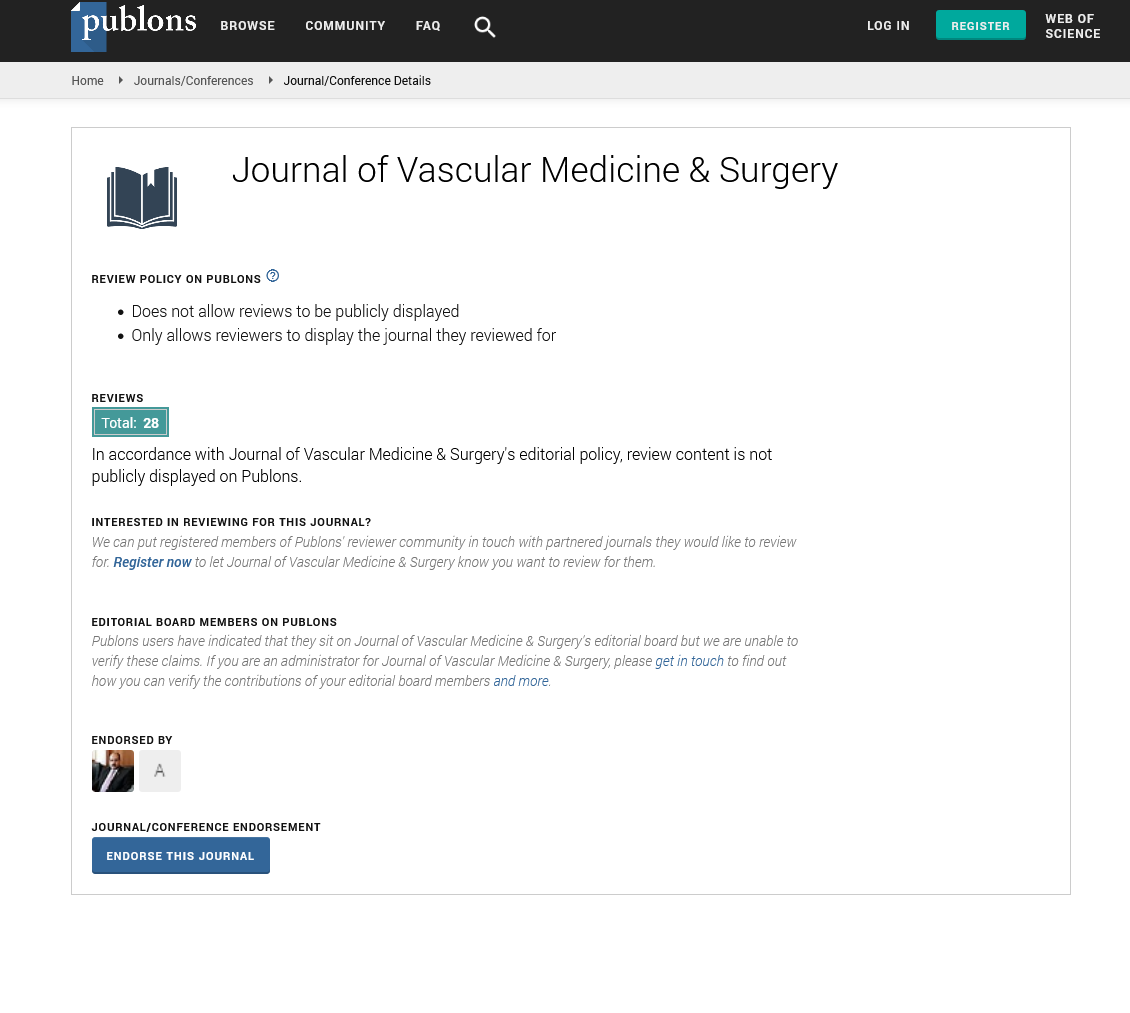Indexed In
- Open J Gate
- Academic Keys
- RefSeek
- Hamdard University
- EBSCO A-Z
- OCLC- WorldCat
- Publons
- Euro Pub
- Google Scholar
- SHERPA ROMEO
Useful Links
Share This Page
Journal Flyer

Open Access Journals
- Agri and Aquaculture
- Biochemistry
- Bioinformatics & Systems Biology
- Business & Management
- Chemistry
- Clinical Sciences
- Engineering
- Food & Nutrition
- General Science
- Genetics & Molecular Biology
- Immunology & Microbiology
- Medical Sciences
- Neuroscience & Psychology
- Nursing & Health Care
- Pharmaceutical Sciences
Perspective - (2025) Volume 13, Issue 7
Transforming Vascular Outcomes Through Innovative Clinical Approaches
Moises Lucca*Received: 19-Jun-2025, Manuscript No. JVMS-25-29907; Editor assigned: 23-Jun-2025, Pre QC No. JVMS-25-29907 (PQ); Reviewed: 07-Jul-2025, QC No. JVMS-25-29907 ; Revised: 14-Jul-2025, Manuscript No. JVMS-25-29907 (R); Published: 21-Jul-2025, DOI: 10.35248/2329-6925.25.13.609
Description
Vascular diseases remain a leading cause of morbidity and mortality worldwide, significantly impacting the quality of life of millions. Conditions such as atherosclerosis, peripheral artery disease, aneurysms, and venous thromboembolism present enormous challenges to healthcare systems and clinicians alike. Historically, the management of vascular diseases has relied heavily on traditional approaches like lifestyle modifications, pharmacotherapy, and invasive surgical interventions. However, the landscape of vascular care is rapidly evolving, driven by innovative clinical approaches that promise to transform outcomes for patients. These innovations are not only redefining treatment paradigms but are also enhancing prevention, diagnosis, and long-term management.
The first significant transformation in vascular care lies in the integration of novel clinical approaches that leverage technological advancements, personalized medicine, and minimally invasive techniques. Traditional open surgeries, once the mainstay of treatment for many vascular conditions, are increasingly being supplemented or replaced by less invasive interventions such as endovascular therapy. These procedures utilize catheters, stents, and balloons to treat vascular diseases through small incisions, leading to reduced recovery times, fewer complications, and enhanced patient comfort.
Innovations in imaging technologies have played a crucial role in this shift. Advanced diagnostic tools like high-resolution ultrasound, Computed Tomography Angiography (CTA), and Magnetic Resonance Angiography (MRA) now provide detailed visualization of vascular structures, enabling earlier and more precise diagnosis. These tools allow clinicians to tailor interventions specifically to the patient’s vascular anatomy and pathology, enhancing the efficacy and safety of treatments.
Moreover, the advent of wearable technology and remote monitoring devices is transforming how vascular patients are managed post-intervention. Continuous monitoring of vital signs, blood flow, and other relevant parameters enables real-time data collection and timely clinical decisions, reducing hospital readmissions and improving long-term outcomes. Such digital health innovations foster a more proactive and personalized approach to vascular care, bridging the gap between hospital and home.
Impact on patient outcomes: Improving quality of life and survival
Innovative clinical approaches are not merely theoretical advancements; their real-world application is translating into measurable improvements in patient outcomes. Minimally invasive procedures, for instance, have revolutionized the treatment of Peripheral Artery Disease (PAD) by restoring blood flow with less trauma, enabling faster ambulation and reduced hospital stays. Such benefits translate into improved functional status and better quality of life, especially important for elderly patients who may not tolerate major surgeries well.
In the management of aneurysms, endovascular repair techniques have significantly reduced perioperative mortality and morbidity compared to open surgical repair. These less invasive methods allow patients to return to daily activities more quickly while maintaining durability and long-term success. Additionally, the continuous refinement of stent designs and materials enhances their performance and longevity, reducing the risk of complications such as restenosis.
The role of innovative pharmacotherapy cannot be overstated in transforming vascular outcomes. Novel anticoagulants, antiplatelet agents, and lipid-lowering drugs have expanded the therapeutic arsenal, enabling better control of thrombosis, inflammation, and atherosclerosis. When combined with personalized medicine, these medications can be optimized for individual patient profiles, balancing efficacy and safety in a way that was not possible before.
Furthermore, the integration of multidisciplinary care models, supported by technological advancements, ensures that patients receive comprehensive management addressing all facets of their condition. Collaborative care involving vascular surgeons, cardiologists, radiologists, and rehabilitation specialists enhances decision-making and facilitates the implementation of the most appropriate interventions. This holistic approach also improves patient adherence to treatment plans and lifestyle modifications, which are critical to long-term success.
Preventive strategies, empowered by innovation, are also gaining prominence. The use of Artificial Intelligence (AI) and machine learning algorithms to analyze large datasets can predict vascular risk with greater accuracy. This predictive capacity allows clinicians to intervene earlier and more aggressively in high-risk populations, potentially averting catastrophic events such as strokes and heart attacks. Lifestyle interventions guided by digital platforms promote sustained behavior change, further reducing the burden of vascular diseases.
Looking ahead: Challenges and opportunities in vascular innovation
While the progress in innovative clinical approaches is promising, several challenges remain in fully realizing their potential to transform vascular outcomes. Accessibility and cost remain significant barriers, especially in low-resource settings. Advanced technologies and personalized therapies may not be readily available to all patients, highlighting the need for equitable healthcare delivery models and policy interventions.
Moreover, the rapid pace of innovation requires continuous education and training for healthcare providers to keep up with evolving techniques and technologies. Integration of new approaches into standard clinical practice must be guided by robust clinical evidence and cost-effectiveness analyses to ensure sustainable healthcare systems.
Conclusion
In conclusion, innovative clinical approaches are fundamentally changing the landscape of vascular disease management. Through minimally invasive procedures, personalized medicine, advanced diagnostics, and digital health technologies, these innovations are improving the precision, safety, and effectiveness of vascular care. The result is better patient outcomes reduced complications, improved survival rates, and enhanced quality of life. As the field continues to evolve, a commitment to equitable access, ongoing education, and ethical practice will be essential to ensure that these transformative benefits reach all patients in need. The future of vascular medicine, driven by innovation, holds immense potential to reduce the global burden of vascular diseases and improve health for millions worldwide.
Citation: Lucca M (2025). Transforming Vascular Outcomes Through Innovative Clinical Approaches. J Vasc Surg. 13:609.
Copyright: © 2025 Lucca M. This is an open-access article distributed under the terms of the Creative Commons Attribution License, which permits unrestricted use, distribution and reproduction in any medium, provided the original author and source are credited.

